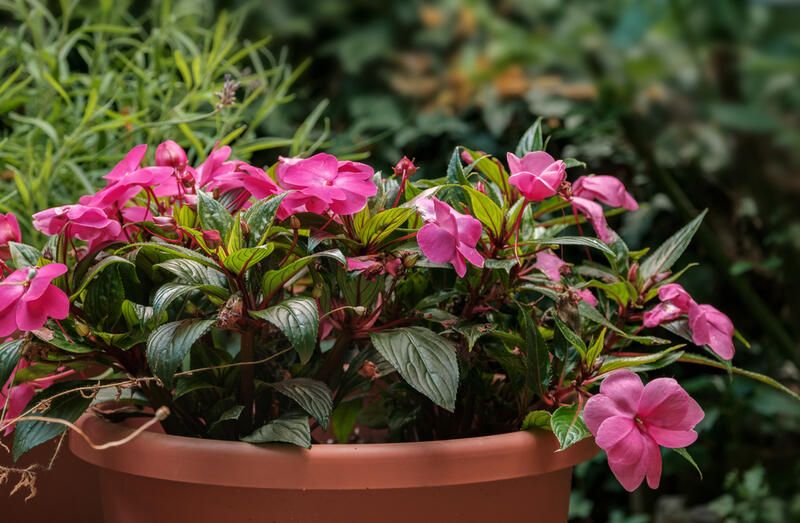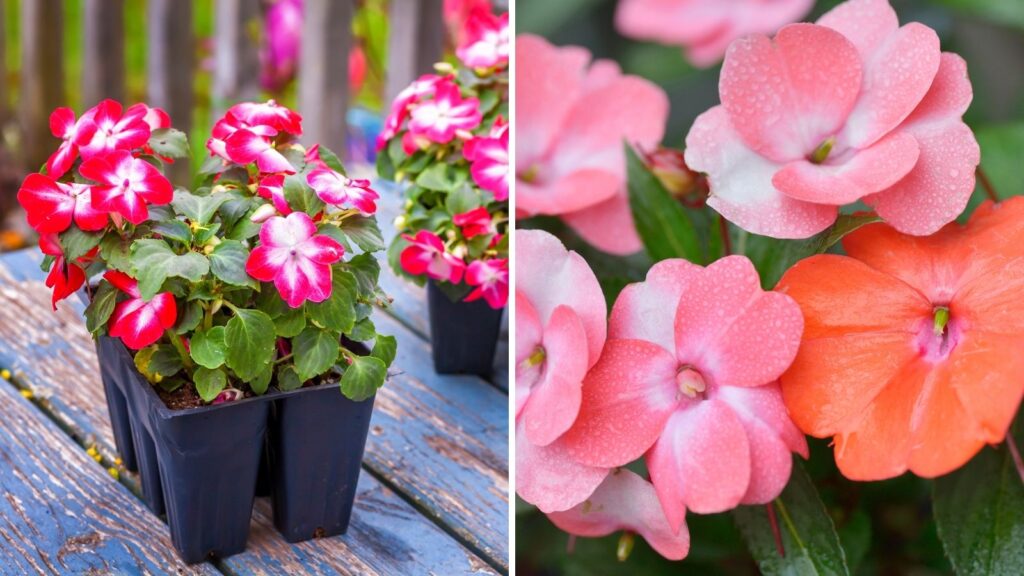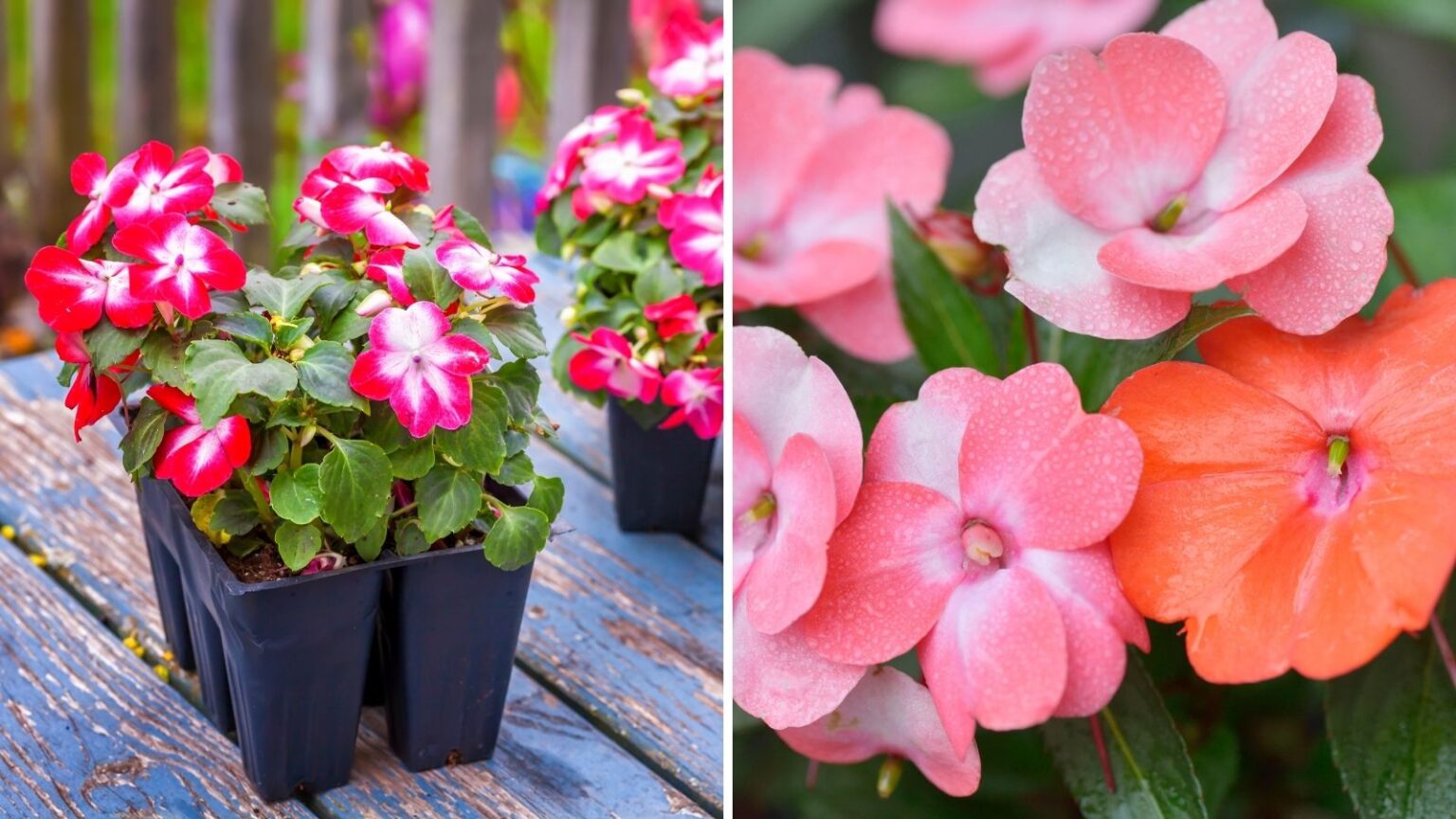Understanding the Needs of Impatiens Plants
Impatiens plants are one of the most popular annuals for shade gardens, and for good reason. With their vibrant colors and delicate blooms, they can add a touch of elegance to any outdoor space. However, to keep these plants thriving, it’s essential to understand their basic needs. When it comes to learning how to care for impatiens, it’s crucial to start with the fundamentals.
Light is one of the most critical factors in impatiens care. While they can tolerate some direct sunlight, most impatiens varieties prefer partial shade to full shade. Placing them in a spot that receives bright, indirect light will help promote healthy growth and prevent scorching. Temperature is also vital, as impatiens prefer daytime temperatures between 65-75°F (18-24°C) and nighttime temperatures around 55-65°F (13-18°C).
Watering is another essential aspect of impatiens care. These plants prefer well-draining soil and should be watered thoroughly, allowing the top inch of soil to dry out between waterings. Overwatering can lead to root rot and other problems, so it’s crucial to avoid getting the leaves wet and to water at the base of the plant instead. By understanding these basic needs, you’ll be well on your way to creating a thriving environment for your impatiens plants.
In addition to light and watering, impatiens also require regular fertilization to promote healthy growth and blooming. A balanced, water-soluble fertilizer can be applied once a month, taking care not to overfertilize. By providing your impatiens with the right balance of light, water, and nutrients, you’ll be rewarded with a vibrant display of color and a lush, healthy plant.
By taking the time to understand the needs of your impatiens plants, you’ll be able to provide them with the care they need to thrive. Whether you’re a seasoned gardener or just starting out, learning how to care for impatiens is a great way to add some beauty and elegance to your outdoor space. With the right care and attention, your impatiens plants will flourish, providing you with a stunning display of color and texture all season long.
Choosing the Right Location for Your Impatiens
When it comes to learning how to care for impatiens, selecting the right location is crucial for their growth and health. Impatiens plants thrive in partial shade to full shade, making them an ideal choice for gardens with limited sunlight. However, it’s essential to choose a location that receives the right amount of sunlight for your specific impatiens variety.
Soil quality is another critical factor to consider when choosing a location for your impatiens. These plants prefer well-draining soil that is rich in organic matter. Avoid planting impatiens in areas with standing water or where water tends to collect, as this can lead to root rot and other problems. If your soil is heavy clay or sandy, consider amending it with compost or well-rotted manure to improve its structure and fertility.
Air circulation is also vital for impatiens plants, as it helps to prevent disease and promotes healthy growth. Choose a location that provides good air circulation, avoiding areas with dense foliage or structures that can block airflow. By selecting a location with the right combination of sunlight, soil quality, and air circulation, you’ll be able to provide your impatiens with the conditions they need to thrive.
In addition to these factors, consider the mature size of your impatiens plants when choosing a location. Some varieties can grow quite large, so make sure to leave enough space between plants for proper growth and air circulation. By choosing the right location and providing the right conditions, you’ll be able to enjoy a vibrant display of color and a lush, healthy plant.
When selecting a location for your impatiens, also consider the surrounding plants and structures. Avoid planting impatiens near plants that are prone to disease or pests, as this can increase the risk of infection. Also, avoid planting impatiens near structures that can provide shade or block airflow, such as trees or buildings.
By taking the time to choose the right location for your impatiens, you’ll be able to provide them with the conditions they need to thrive. With the right combination of sunlight, soil quality, air circulation, and space, your impatiens plants will flourish, providing you with a stunning display of color and texture all season long.
Watering Impatiens: How to Avoid Overwatering and Underwatering
Watering is a crucial aspect of learning how to care for impatiens. These plants prefer moist soil, but overwatering can be detrimental to their health. To avoid overwatering, check the soil moisture by inserting your finger into the soil up to the first knuckle. If the soil feels dry, it’s time to water. If it’s already moist, wait another day or two before watering again.
When watering impatiens, make sure to water at the base of the plant, avoiding the leaves to prevent fungal diseases. Water thoroughly, allowing the top inch of soil to dry out between waterings. Avoid getting water on the leaves or crown of the plant, as this can cause rot and other problems.
Underwatering can also be a problem for impatiens, especially during hot and dry weather. If the soil is too dry for too long, the plant may drop its leaves or become stressed. To prevent underwatering, make sure to water impatiens regularly, especially during periods of drought or high temperatures.
It’s also important to avoid watering impatiens in the evening, as this can encourage fungal growth and other problems. Instead, water in the morning, allowing the plant to dry out slightly before nightfall. By watering correctly, you can help prevent common problems and keep your impatiens healthy and thriving.
In addition to proper watering techniques, it’s also important to monitor the soil moisture levels. If the soil is consistently waterlogged or dry, it may be necessary to adjust the watering schedule. By paying attention to the soil moisture levels and adjusting the watering schedule accordingly, you can help ensure that your impatiens receive the right amount of water.
By following these tips and learning how to care for impatiens, you can help prevent common watering mistakes and keep your plants healthy and thriving. Remember to water correctly, monitor soil moisture levels, and adjust the watering schedule as needed to ensure the best results.
Fertilizing Impatiens for Optimal Growth
Fertilizing is an essential part of learning how to care for impatiens. These plants require a balanced diet of nutrients to promote healthy growth and vibrant blooms. A well-balanced fertilizer that contains equal amounts of nitrogen, phosphorus, and potassium (NPK) is ideal for impatiens.
When selecting a fertilizer for your impatiens, consider using a water-soluble fertilizer that can be applied directly to the soil. This type of fertilizer is easy to use and provides quick results. You can also use a slow-release fertilizer that provides nutrients to the plant over a longer period.
It’s essential to follow the instructions on the fertilizer package and avoid overfertilizing. Overfertilizing can damage the plant and cause more harm than good. Start with a small amount of fertilizer and gradually increase the amount as needed.
In addition to using a balanced fertilizer, you can also use organic matter such as compost or well-rotted manure to provide nutrients to your impatiens. These natural fertilizers are rich in nutrients and can help improve the soil structure and fertility.
Fertilizing impatiens regularly can promote healthy growth and encourage vibrant blooms. It’s essential to fertilize your impatiens at the right time, usually during the growing season when the plant is actively producing new growth. Avoid fertilizing during the dormant season, as this can cause the plant to produce new growth that may not be hardy enough to withstand the cold weather.
By fertilizing your impatiens regularly and using the right type of fertilizer, you can promote healthy growth and encourage vibrant blooms. Remember to follow the instructions on the fertilizer package and avoid overfertilizing to ensure the best results.
Pruning and Grooming Impatiens for Maximum Impact
Pruning and grooming are essential steps in learning how to care for impatiens. Regular pruning can help maintain the plant’s shape, promote healthy growth, and encourage vibrant blooms. To prune impatiens, start by removing any dead or dying leaves or stems. This will help prevent the spread of disease and encourage new growth.
Next, trim back overgrown stems to maintain the plant’s shape and promote bushy growth. Use a pair of clean, sharp scissors or pruning shears to make clean cuts just above a leaf node. This will help the plant heal quickly and reduce the risk of disease.
In addition to pruning, regular grooming can also help keep impatiens looking their best. Remove any weeds or debris that may be competing with the plant for water and nutrients. Also, inspect the plant regularly for signs of pests or disease, and take action promptly if you notice any issues.
Pruning and grooming impatiens can also help promote healthy growth and encourage vibrant blooms. By removing dead or dying leaves and stems, you can help the plant focus its energy on producing new growth and blooms. Regular pruning can also help maintain the plant’s shape and promote bushy growth, making it a more attractive addition to your garden.
When pruning impatiens, it’s essential to make clean cuts and avoid damaging the plant. Use a pair of clean, sharp scissors or pruning shears, and make cuts just above a leaf node. This will help the plant heal quickly and reduce the risk of disease. Also, prune impatiens in the morning, when the plant is at its highest water content, to minimize stress and prevent shock.
By pruning and grooming impatiens regularly, you can help maintain their shape, promote healthy growth, and encourage vibrant blooms. Remember to prune and groom your impatiens regularly to keep them looking their best and to promote optimal growth and health.
Pest and Disease Management for Impatiens
Impatiens plants are susceptible to various pests and diseases that can affect their growth and health. To learn how to care for impatiens, it’s essential to understand how to identify, prevent, and treat these issues. Common pests that can affect impatiens include aphids, whiteflies, and spider mites. These pests can cause damage to the plant’s leaves and stems, leading to reduced growth and flowering.
To prevent pest infestations, inspect your impatiens plants regularly for signs of pests. Use neem oil or insecticidal soap to control infestations, and make sure to follow the product’s instructions carefully. It’s also essential to maintain good garden hygiene, removing any weeds or debris that can harbor pests.
Impatiens plants are also susceptible to various diseases, including powdery mildew, leaf spot, and root rot. These diseases can cause damage to the plant’s leaves and stems, leading to reduced growth and flowering. To prevent disease, make sure to provide your impatiens plants with good air circulation, and avoid overhead watering, which can splash water onto the leaves and create an environment conducive to disease.
If you notice any signs of disease, such as yellowing leaves or black spots, remove the affected leaves or stems immediately. Use a fungicide specifically designed for impatiens to treat the disease, and make sure to follow the product’s instructions carefully.
In addition to using chemical controls, there are also several organic methods you can use to manage pests and diseases on your impatiens plants. For example, you can use diatomaceous earth to control slugs and snails, or use garlic spray to repel aphids and other pests.
By understanding how to identify, prevent, and treat pests and diseases, you can help keep your impatiens plants healthy and thriving. Remember to inspect your plants regularly, maintain good garden hygiene, and use a combination of chemical and organic controls to manage any issues that arise.
Propagating Impatiens: How to Share Plants with Friends and Family
Propagating impatiens is a great way to share these beautiful plants with friends and family. There are several methods to propagate impatiens, including stem cuttings, division, and seed. By learning how to propagate impatiens, you can easily share these plants with others and enjoy their vibrant blooms in your own garden.
One of the easiest methods to propagate impatiens is through stem cuttings. To do this, simply cut off a healthy stem from the mother plant, remove any lower leaves, and plant the cutting in a pot filled with moistened potting soil. Keep the soil consistently moist and warm, and roots should develop within a few weeks.
Another method to propagate impatiens is through division. This involves carefully digging up the entire plant, gently separating the roots, and replanting the separated sections in new pots. This method is best done in the spring or fall, when the plant is dormant.
Impatiens can also be propagated through seed. To do this, simply collect the seeds from the mother plant, sow them in a pot filled with moistened potting soil, and keep the soil consistently moist and warm. Seeds should germinate within a few weeks, and the resulting seedlings can be transplanted into individual pots.
Regardless of the method used, it’s essential to provide the newly propagated impatiens with the right conditions to thrive. This includes providing bright, indirect light, consistent moisture, and fertilization. By following these tips, you can successfully propagate impatiens and share these beautiful plants with friends and family.
When propagating impatiens, it’s also essential to consider the timing. Spring and summer are the best times to propagate impatiens, as the weather is warm and the days are long. Avoid propagating impatiens in the fall or winter, as the cooler temperatures and shorter days can make it more challenging for the new plants to establish themselves.
By learning how to propagate impatiens, you can easily share these beautiful plants with others and enjoy their vibrant blooms in your own garden. Whether you’re a seasoned gardener or just starting out, propagating impatiens is a great way to expand your plant collection and share your love of gardening with others.
Common Mistakes to Avoid When Caring for Impatiens
When learning how to care for impatiens, it’s essential to avoid common mistakes that can harm the plant’s growth and health. One of the most common mistakes is overwatering, which can lead to root rot and other problems. To avoid overwatering, make sure to check the soil moisture regularly and only water when the soil feels dry to the touch.
Underwatering is another common mistake that can affect impatiens plants. If the soil is too dry for too long, the plant may drop its leaves or become stressed. To avoid underwatering, make sure to water impatiens regularly, especially during hot and dry weather.
Neglecting fertilization is another mistake that can affect impatiens plants. Fertilization is essential for promoting healthy growth and vibrant blooms. To avoid neglecting fertilization, make sure to fertilize impatiens regularly, using a balanced fertilizer that contains equal amounts of nitrogen, phosphorus, and potassium.
Not providing enough light is another common mistake that can affect impatiens plants. Impatiens need bright, indirect light to thrive, so make sure to place them in a spot that receives plenty of light. Avoid placing impatiens in direct sunlight, as this can cause the leaves to become scorched.
Not pruning or grooming impatiens regularly is another mistake that can affect the plant’s appearance and health. Regular pruning can help maintain the plant’s shape, promote healthy growth, and encourage vibrant blooms. To avoid neglecting pruning and grooming, make sure to prune and groom impatiens regularly, removing any dead or dying leaves or stems.
By avoiding these common mistakes, you can help ensure that your impatiens plants thrive and provide vibrant color to your garden. Remember to check the soil moisture regularly, fertilize regularly, provide enough light, and prune and groom regularly to keep your impatiens healthy and happy.


:max_bytes(150000):strip_icc()/care-for-new-guinea-impatiens-4122333-03-6383e56492044445a2459a5dd526a422.jpg)



